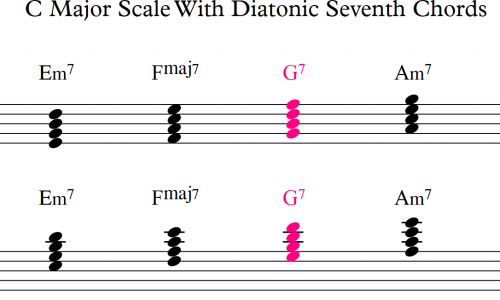
Harmony in music: major and minor
Contents
Our next issue is dedicated to such a phenomenon as lad. We will try to answer the following questions: what is a mode in music, how can this concept be defined, and what are the varieties of musical modes.
So what is fret? Remember what this word means outside of music? In life, they sometimes say about people that they get along with each other, that is, they are friends, understand each other and provide mutual assistance. In music, sounds must also get along with each other, be in harmony, otherwise it will not be a song, but one continuous cacophony. It turns out that harmony in music is sounds that are friendly with each other.
Fret basics
There are a lot of sounds in the song and they are different. There are sounds that are stable – supporting, and there are unstable – moving. In order to make music, both are needed, and they must alternate with each other and help each other.
The construction of music can be likened to the construction of a brick wall. As a wall is made of bricks and cement between them, so a song is born only when there are stable and unstable sounds.

Steady sounds bring peace to music, they slow down active movement, they usually end a piece of music. Unstable sounds are needed for development; they constantly lead the development of the melody away from stable sounds and lead back to them again. All unstable sounds tend to turn into stable ones, and stable ones, in turn, like magnets attract unstable ones.
Why are stable and unstable sounds working so tirelessly in harmony? In order to get some kind of song – funny or sad. That is, the sounds of the fret can also affect the mood of the music, they seem to mow the melodies into different emotional shades.
Types of fret: major and minor
So, a mode is always a whole team of sounds that work tirelessly to create songs of all kinds of moods. There are a lot of modes in music, but there are two of the most important. They are called major and minor.
The major scale, or simply major, is the tone of light and fun. It is suitable for creating joyful, cheerful and cheerful music. The minor scale, or simply minor, is the master of sad and thoughtful music.

The major mode is a bright sun and a clear blue sky, and the minor mode is a scarlet sunset and the peaks of a spruce forest darkening under it. The major scale is the bright green spring grass on the lawn, which the gray goat eats with great pleasure. The minor mode is to watch from the window in the evening how autumn leaves fall and autumn rain crystals drip. Beauty can be different, and major and minor – two artists who are ready to paint any picture with their sounds.

TIP. If you are working with children, then it will be useful to work with pictures. Show the child a series of pictures, let him imagine how they could sound – major or minor? You can download the finished collection from us. As a creative task, the child can be offered to create his own gallery of major and minor images. This will awaken his creative imagination.
A SELECTION OF PICTURES “MAJOR AND MINOR” – DOWNLOAD
Such well-known songs as “A Christmas tree was born in the forest”, the solemn Anthem of the Russian Federation, and the sunny “Smile” were composed in a major scale. The songs “A grasshopper sat in the grass” and “A birch stood in the field” are composed in a minor scale.
QUIZ. Listen to two pieces of music. These are two dances from the “Children’s Album” by Pyotr Ilyich Tchaikovsky. One dance is called “waltz”, the other – “mazurka”. Which one do you think is in major and which is in minor?
Fragment No. 1 “Waltz”
Fragment No. 2 “Mazurka”
Correct answers: “Waltz” is major music, and “Mazurka” is minor.
Key and gamma
Major and minor modes can be built from any musical sound – from do, from re, from mi, etc. This first, most important sound will be called the tonic in harmony. And the height position of the fret, linking it to some kind of tonic, is denoted by the word “tonality”.
Each tonality should be called somehow. A person has a first name and a last name, and a key has the name of the tonic and mode, which can also be combined into one name. For example, C major (the note DO is the tonic, that is, the main sound, the captain of the team, a fret is built from it, and the fret is major). Or another example: D minor is a minor scale from the note PE. Other examples: E major, F major, G minor, A minor, etc.

THE TASK. Try to make up some name for the key yourself. Take any tonic and any fret, put it together. What did you get?
If you put all the sounds of the key in order, starting with the tonic, you get a scale. The scale starts with the tonic and ends with it. By the way, the scales are named exactly the same as the keys. For example, the E minor scale begins with the note MI and ends with the note MI, the G major scale begins with the note S and ends with the same note. Do you understand? Here’s a musical example:


But where do sharps and flats come from in these scales? Let’s talk about this further. It turns out that major and minor scales have their own special structure.
Major scale structure
To get a major scale, you need to take only eight sounds and line them up. But not all sounds suit us. How to choose the right ones? You know that the distance between the steps can be half a tone or a whole tone. So, for a major scale, it is necessary that the distance between its sounds correspond to the formula: tone-tone, semitone, tone-tone-tone, semitone.

For example, the C major scale starts with the note DO and ends with the note DO. Between the sound DO and RE there is a distance of one whole tone, between RE and MI there is also a tone, and between MI and FA it is only half a tone. Further: between FA and SOL, SOL and LA, LA and SI for a whole tone, between SI and upper DO – only a semitone.

Let’s deal with tones and semitones
If you forgot what tones and semitones are, then let’s repeat it. A semitone is the shortest interval from one note to the next. The piano keyboard shows us the semitones between sounds very clearly. If you play all the keys in a row, without skipping either white or black, then when moving from one key to the next, we will just go through a distance of one semitone.
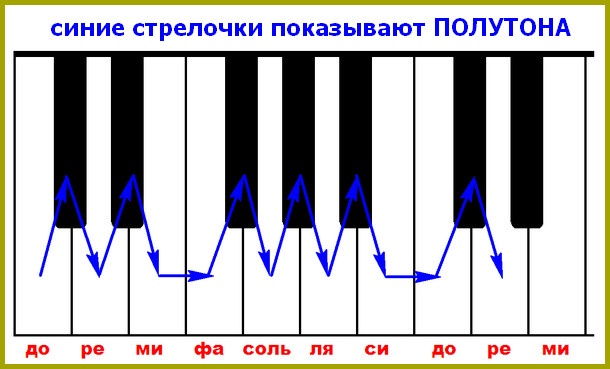
As you can see, a semitone can be played by going up from a white key to the nearest black one, or going down from a black one to a white one, which is right next to it. In addition, which are formed only between “white” sounds: these are MI-FA and SI-DO.
A semitone is a half, and if you reunite the two halves together, you get something whole, you get one whole tone. On a piano keyboard, whole tones can easily be found between two adjacent white keys if they are separated by a black one. That is, DO-RE is a tone, and RE-MI is also a tone, but MI-FA is not a tone, it is a semitone: nothing separates these white keys.
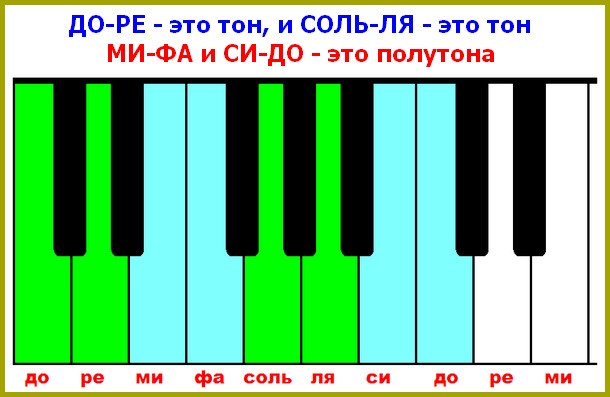
To get a whole tone from the note MI in a pair, you need to take not a simple FA, but FA-SHARP, that is, add another half tone. Or you can leave the FA, but then you have to lower the MI, take the MI-FLAT.
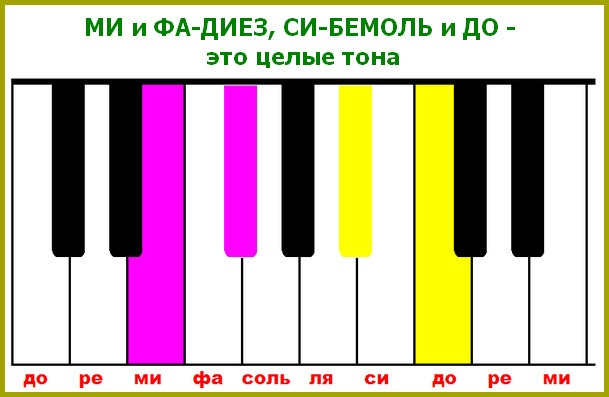
As for the black keys, on the piano they are arranged in groups – two or three. So, inside the group, two adjacent black keys are also removed from each other by one tone. For example, C-SHARP and D-SHARP, as well as G-FLAT and A-FLAT, are all combinations of notes that give us whole tones.
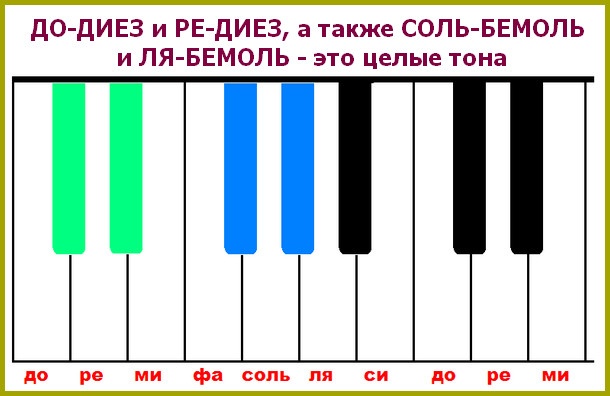
But in large gaps between groups of black “buttons”, that is, where two white keys are placed between two black keys, the distance will be one and a half tones (three semitones). For example: from MI-flat to F-sharp or from SI-flat to C-sharp.
More details about tones and semitones can be found in the article Accidentals.
Building major scales
So, in the major scale, the sounds should be arranged in such a way that between them there are first two tones, then semitones, then three tones and again a semitone. As an example, let’s construct the D major scale. First, we make a “blank” – we write notes in a row from the lower sound PE to the upper PE. Indeed, in D major, the sound PE is the tonic, the scale must begin with it and it must end with it.

And now you need to “find out the relationship” between the sounds and bring them into line with the major scale formula.
- There is a whole tone between RE and MI, everything is fine here, let’s move on.
- Between MI and FA is a semitone, but in this place, according to the formula, there should be a tone. We straighten it out – by increasing the sound of the FA, we add another half tone to the distance. We get: MI and F-SHARP – one whole tone. Now order!
- F-SHARP and SALT give us a semitone that should just be in third place. It turns out that it was not in vain that we raised the FA note, this sharp was still useful to us. Move on.
- SOL-LA, LA-SI are whole tones, as it should be according to the formula, we leave them unchanged.
- The next two sounds SI and DO are a semitone. You already know how to straighten it: you need to increase the distance – put a sharp in front of DO. If it were necessary to reduce the distance, we would put it flat. Do you understand the principle?
- The last sounds – C-SHARP and RE – are a semitone: what you need!
What did we end up with? It turns out that there are two sharps in the D major scale: F-SHARP and C-SHARP. Do you understand now where they came from?

Similarly, you can build major scales from any sounds. And there, too, either sharps or flats will appear. For example, in F major there is one flat (SI-FLAT), and in C major there are as many as five sharps (DO, RE, FA, SOL and A-SHARP).


You can build scales not only from the “white keys”, but also from lowered or raised sounds. Do not forget to take into account the signs you know. For example, the E-flat major scale is a scale with three flats (MI-flat itself, A-flat and B-flat), and the F-sharp major scale is a scale with six sharps (all sharps except C-sharp).


The structure of the minor scale
Here the principle is almost the same as with major scales, only the formula for the structure of the minor scale is slightly different: tone, semitone, tone-tone, semitone, tone-tone. By applying this sequence of tones and semitones, you can easily get a minor scale.

Let’s turn to examples. Let’s build a minor scale from the note SALT. First, just write out all the notes in order from G to G (from the lower tonic to its repetition at the top).

Next, we look at the distances between the sounds:
- Between SALT and LA – a whole tone, as it should be according to the formula.
- Further: LA and SI are also a tone, but a semitone is needed in this place. What to do? It is necessary to reduce the distance, for this we lower the SI sound with the help of a flat. Here we have the first sign – B-flat.
- Further, according to the formula, we need two whole tones. Between the sounds B-flat and DO, as well as DO and RE, there is just such a distance as it should be.
- Next: RE and MI. There is a whole tone between these notes, but only a semitone is needed. Again, you already know the treatment: we lower the note MI, and we get a semitone between RE and MI-FLAT. Here is the second sign for you!
- We check the last: we need two more whole tones. MI FLAT with FA is a tone, and FA with SA is also a tone. Everything is OK!
What did you get in the end? There are two flats in the G minor scale: SI-FLAT and MI-FLAT.

For practice, you can build yourself or “pick up” several minor scales: for example, F sharp minor and A minor.


How else can you get a minor scale?
Major and minor scales, built from the same tonic, differ from each other by only three sounds. Let’s find out what these differences are. Let’s compare the scale C major (no signs) and C minor (three flats).

Each sound of the scale is a degree. So, in the minor scale, compared to the major scale, there are three low steps – the third, sixth and seventh (marked with Roman numerals – III, VI, VII). Thus, if we know the major scale, then we can easily get a minor scale by changing just three sounds.
For the exercise, let’s work with the key of G major. In the G major scale, one sharp is F-SHARP, which is the seventh degree of the scale.
- We lower the third step – the note SI, we get SI-FLAT.
- We lower the sixth step – the note MI, we get MI-FLAT.
- We lower the seventh step – the note F-SHARP. This sound is already elevated, and in order to lower it, you just need to cancel the increase, that is, remove the sharp.
Thus, in G minor there will be only two signs – SI-FLAT and MI-FLAT, and F-SHARP simply disappears from it without a trace. As you can see, nothing complicated.
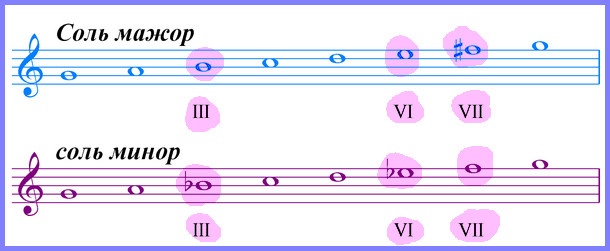
Steady and unstable sounds in major
There are seven steps in both the major and minor scales, three of which are stable, and four are unstable. The stable steps are the first, third and fifth (I, III, V). Unstable – this is all the rest – the second, fourth, sixth, seventh (II, IV, VI, VII).

Stable steps, if put together, form a tonic triad, that is, a triad built from the tonic, from the first step. The word triad means a chord of three sounds. The tonic triad is abbreviated as T53 (in major) or with a small letter t53 (in minor).

In the major scale, the tonic triad is major, and in the minor scale, respectively, minor. Thus, a triad of stable steps gives us a complete picture of the tonality – its tonic and mode. The sounds of the tonic triad are a kind of guide for musicians, according to which they are tuned to the beginning of the work.

As an example, let’s look at stable and unstable sounds in D major and in C minor.
D major is a light tonality with two sharps (FA-SHARP and C-SHARP). The stable sounds in it are RE, F-SHARP and LA (the first, third and fifth notes from the scale), together they give us a tonic triad. The unstable ones are MI, SALT, SI and C-SHARP. Look at the example: unstable steps are shaded for better clarity:

C minor is a scale with three flats (B-Flat, E-Flat and A-Flat), it is minor and therefore sounds with a slight hint of sadness. The stable steps here are DO (first), MI-FLAT (third) and G (fifth). They give us a minor tonic triad. The unstable steps are RE, FA, A-FLAT, and B-FLAT.

So, in this issue, we got acquainted with such musical concepts as mode, tonality and scale, examined the structure of major and minor, learned how to find stable and unstable steps. From the following issues, you will learn about what are the varieties of major and minor and what are the other modes in music, as well as how to quickly identify sharps and flats in any key.





